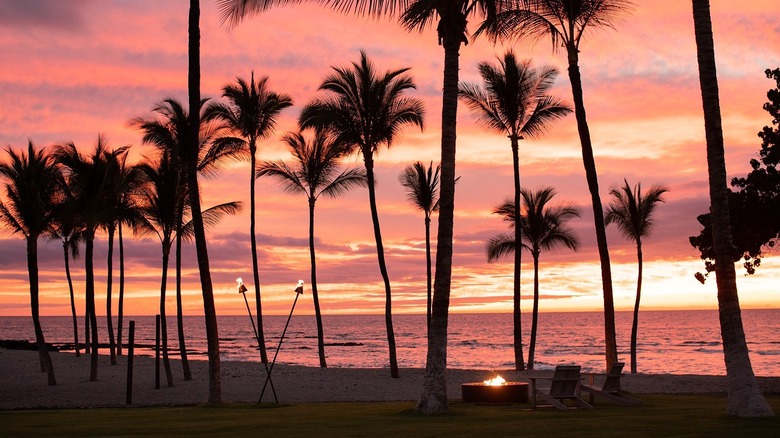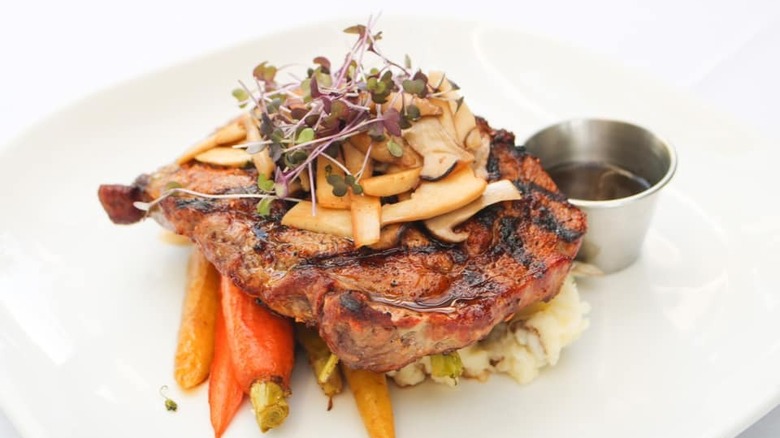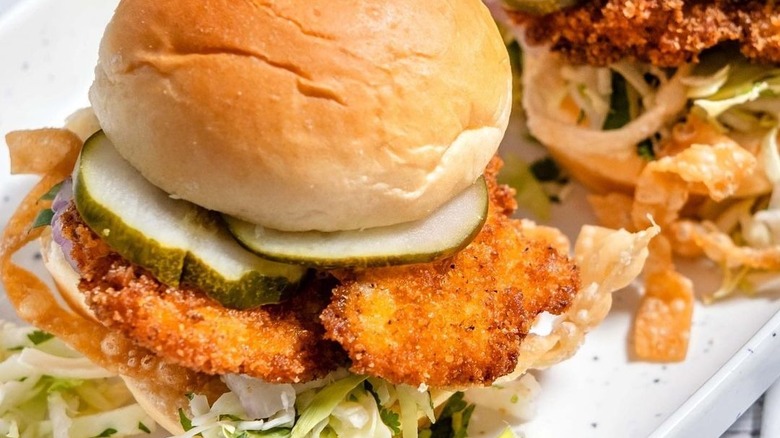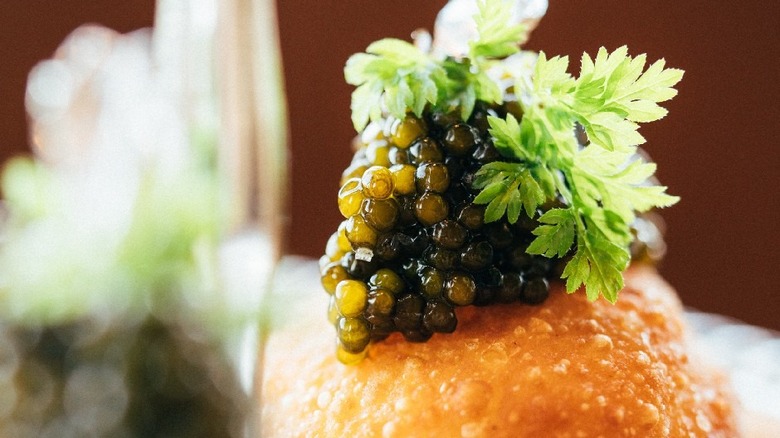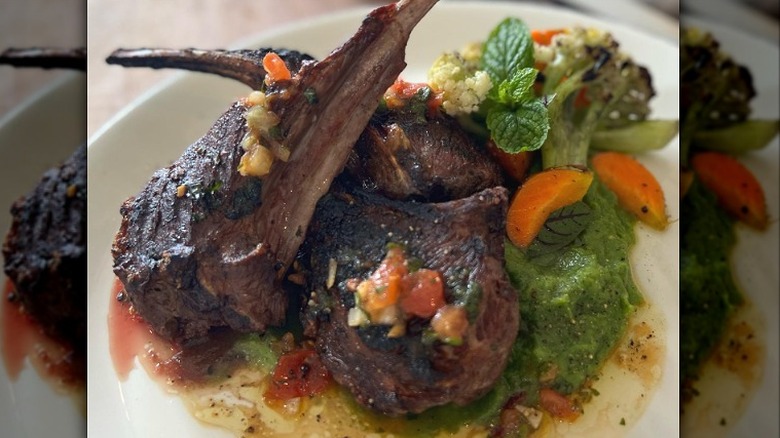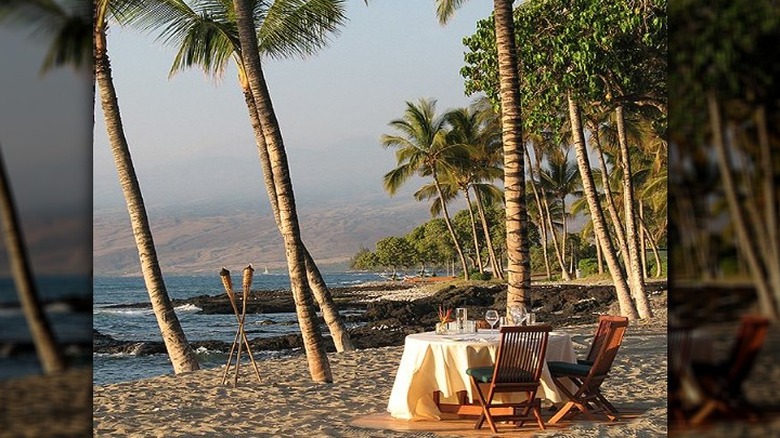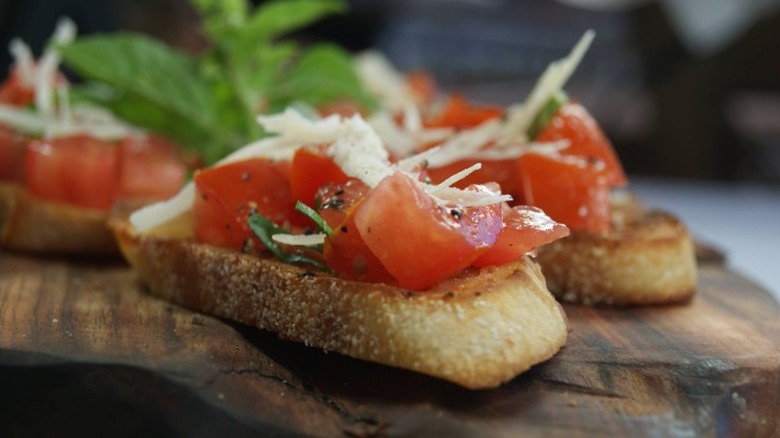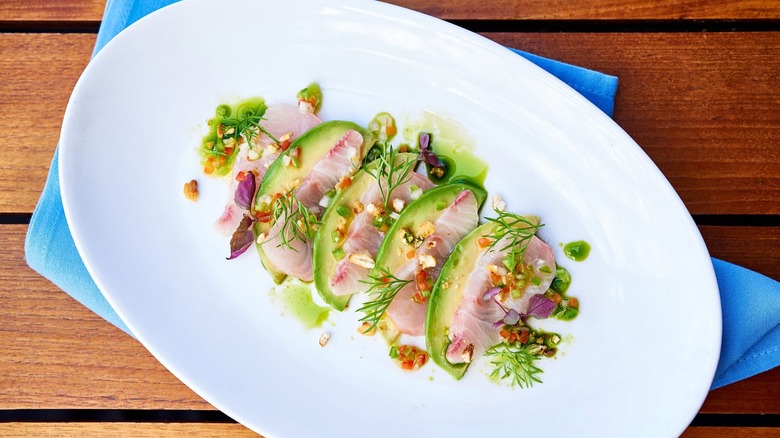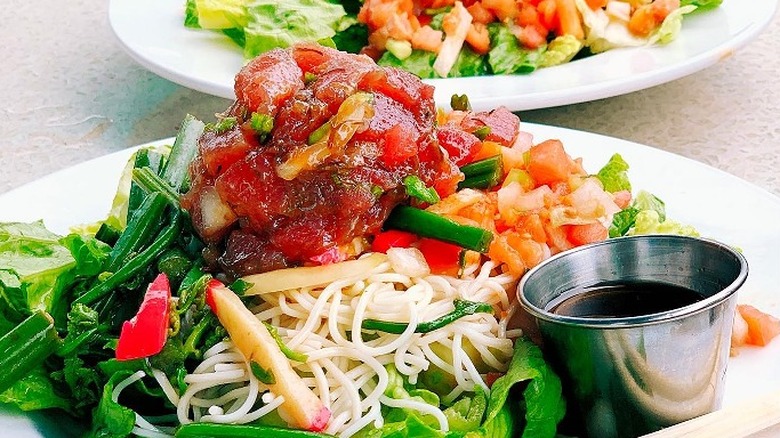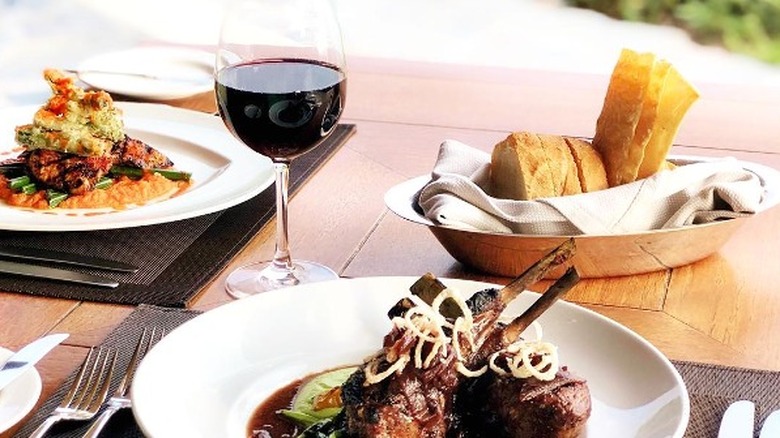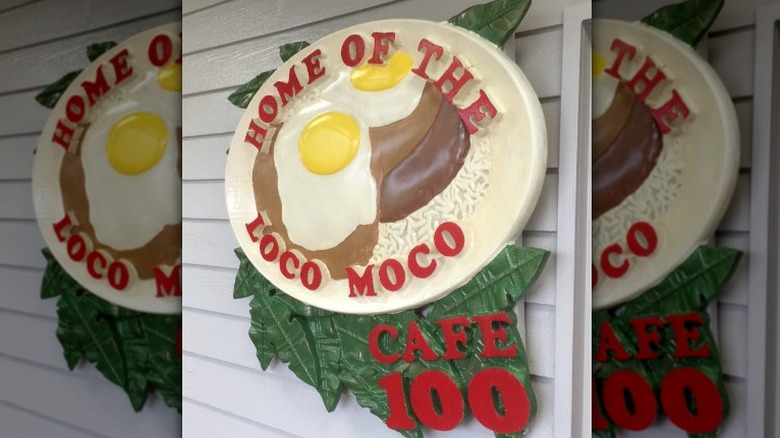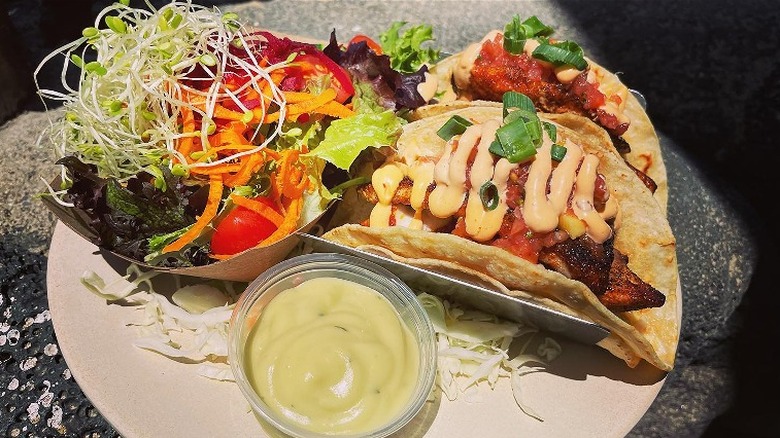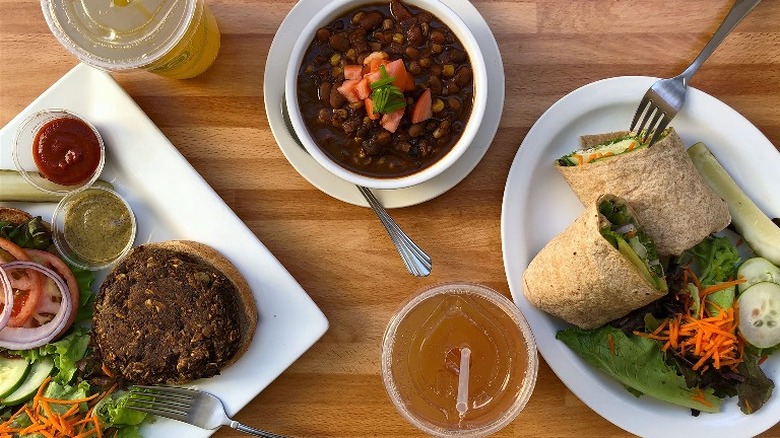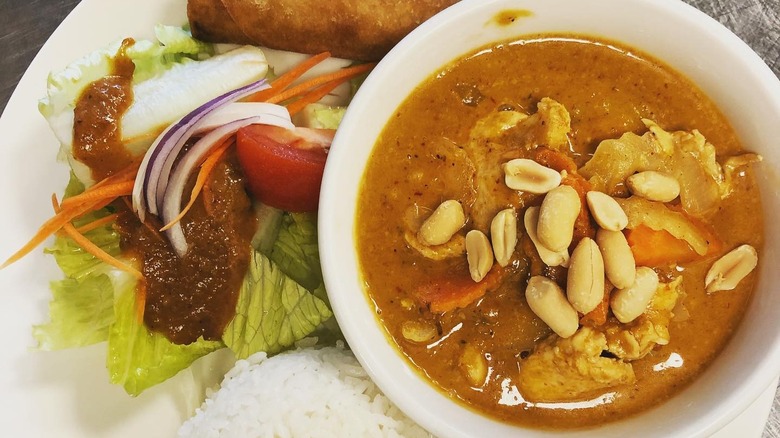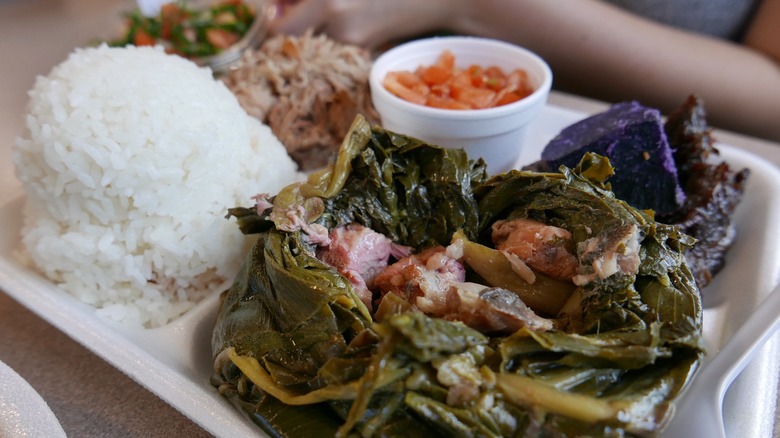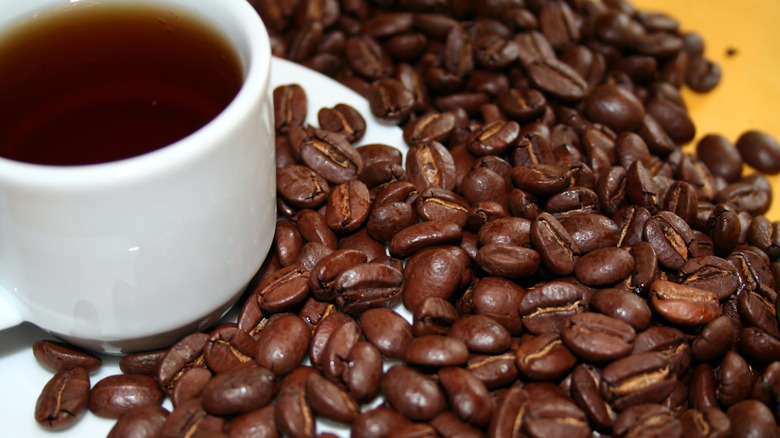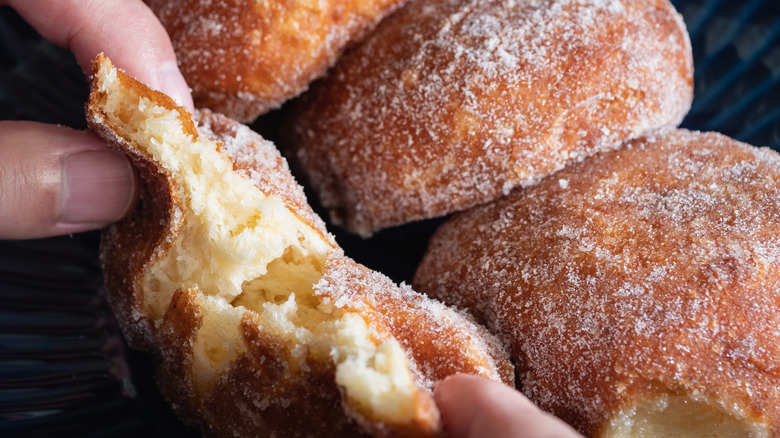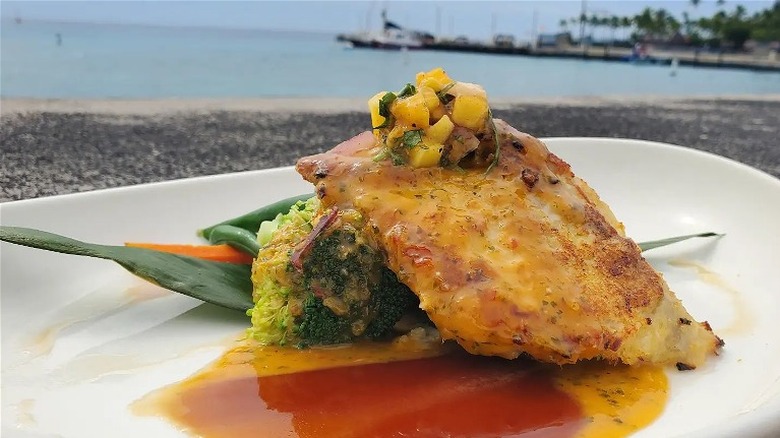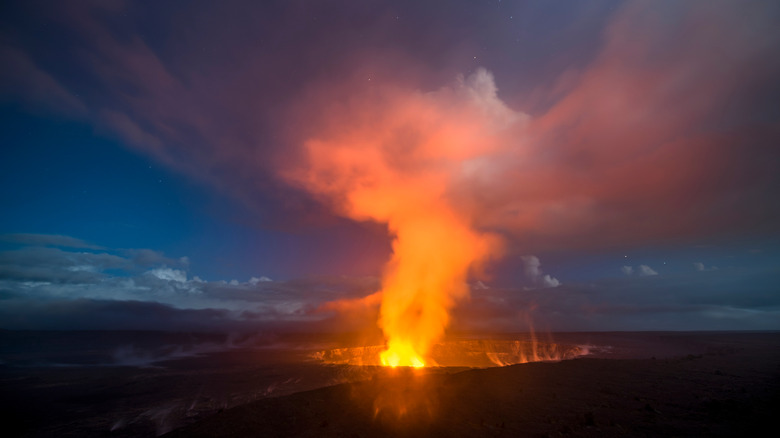The 18 Best Places To Eat On The Big Island Of Hawaii
Affectionately referred to as the Big Island, Hawaii Island is the largest and most unique island in the state, with a land mass spanning over 4,000 miles, (per PBS). Beaches of black, green, and white dot the island's coasts from Hilo to Hawi, Kona to Kamuela, notes South Kohala Management. Hawaii Magazine shares 10 of the 14 microclimates on earth are on the Big Island, from rainforests and waterfalls to stark lava fields flowing into the sea. The Big Island is home to five of America's volcanoes, including the world's tallest mountain, Mauna Kea, sitting at over 33,000 feet, adds NOAA.
With such diversity, the Big Island is fitting for adventure seekers and those looking to relax under a palm tree while sipping a citrusy Mai Tai cocktail, where today's forecast is likely sunny with a chance of rainbows. The island's laid-back attitude is steeped in the local belief in living aloha. For islanders, aloha is more than a greeting. Aloha is a lifestyle embracing peace, unity, and compassion, (via Surfer Magazine).
When it's time to eat, the Big Island offers a mix of enticing flavors, served with aloha for the āina (land) and kai (ocean). Locals include a melting pot of nationalities and cultures, including native Polynesian Hawaiians, Japanese, Filipino, Portuguese, and mainlanders, reports DataUSA. In Hawaii, each culture brings unique flavors and traditions to the island's cuisine. From posh resort dining to casual beach shacks and shave ice, these restaurants offer an authentic taste of the island.
Napua
On the south side of the Mauna Lani resort on the Kohala Coast, steps away from the historic Kalahuipua'a Fishponds adjacent to Makaiwa Bay, is Napua. By day, Napua is a casual beach restaurant serving fruity cocktails, smoothies, and burgers to visitors of the Mauna Lani Beach Club. Transitioning from day to night, Napua's tables receive a white tablecloth drape as local musicians strum a Hawaiian melody under a sea of twinkle lights. Napua becomes a dreamy spot for diners to watch the sun sink into the ocean.
Begun by friends and brothers-in-law, chef Keoni Regidor and restauranteur turned farmer Brandon Lee, Napua features locally grown meat, fish, and produce, showcased with Hawaiian flare in the open-air restaurant. Lee is also the owner of Kaunamano Farms, sustainably raising Berkshire pigs, which Napua features in its nightly menu in everything from pork chops and ribs to smoky, creamy Kaunamano Farm pork spread with Kulinalani black sourdough bread. Everything the restaurant uses is grown between Honoka'a and Mauna Lani, ensuring seasonality and freshness with flavors representing the land.
Tommy Bahama
Tommy Bahama is a successful clothing store and furniture brand that owns a chain of restaurants and bars across the country. We spoke with Big Island Assistant General Manager Liz Costigan about what sets the Big Island location in the Shops at Mauna Lani apart from the 20 or so other Tommy Bahama Restaurants and Marlin Bars.
Costigan says much of the Big Island's success is due to working with local purveyors who provide the highest quality produce and products grown on the island, including produce from executive chef Stennis Hirayama. Costigan adds Hirayama grew up on his family's farm, Y. Hirayama Farm, Inc., in Waimea before attending culinary school in Portland, Oregon. He returned to Hawaii, taking the leadership role at Tommy's in 2012. His family's Hirayama Farm, and surrounding Waimea farms, like Kawamata Farms, have supplied produce to the restaurant for years. Costigan says, "It is essential to Tommy Bahama to not only source and support local but also use the freshest ingredients possible."
Working by the motto that "life is one long weekend," island flavors served in a relaxing atmosphere define the island life of Tommy Bahama Mauna Lani. And don't miss happy hour from 3 p.m. to 5 p.m. daily to enjoy Costigan's favorite cocktail, a grapefruit basil martini made with freshly squeezed juice, or our favorite, a heavenly coconut cloud.
'Ulu Ocean Grill
Within the luxurious Four Seasons Hualalai Hotel on the southern end of the Kohala Coast, beneath the shadow of the 300,000-year-old Hualalai volcano is 'Ulu Ocean Grill. Though you can enjoy island-inspired steaks, fish, and poultry, the sushi at 'Ulu is the best on the island. With incredible precision and care, chef Nuri Piccio showcases an array of sushi and sashimi dishes from fish flown in fresh from Japan or caught locally.
Succulent dishes include Kona kampachi, ahi nigiri, maki rolls made with ahi and mango, and, our favorite, the Ora seared salmon and sweet Thai miso roll with spicy slivered red onion. Seasonally, 'Ulu also features a selection of fresh oysters with Hawaiian chili pepper water raised in the on-property fishery. We suggest finishing the night with a chocolate soufflé or a boozy rum-infused pineapple upside-down cake.
Merriman's
In 1983, Pittsburg native Peter Merriman arrived on the Big Island to be a cook at the Mauna Lani Bay Hotel. At the time, Merriman thought he would stay a short time, enjoy a little sun and surf, and then head back to the East Coast. Instead, he made Hawaii his permanent home, becoming one of the first chefs on the island to focus on regional Hawaiian cuisine, featuring local meat, fish, and produce.
At the time, Hawaii was still an island of sugarcane and pineapple plantations. While working at the Mauna Lani, Merriman began encouraging local farmers to grow fresh produce, like berries and tomatoes, which he purchased to use in the hotel's restaurant.
When Merriman opened his signature restaurant, Merriman's, in upcountry Waimea in 1988, the island's farmers became his culinary partners. Today, Merriman's features farm-to-table dishes with 90% of the ingredients sourced on the island. Favorite dishes include Kua'aina beef tenderloin, Lehua taro cakes, and Hiraraba Farm beet and fennel salad with Hawaiian goat cheese. Locations on Maui, Oahu, and Kauai today join Merriman's original site on the Big Island.
CanoeHouse
For the past 40 years, the Mauna Lani Bay Hotel has welcomed visitors to its historic Kohala Coast location, sandwiched between thousands of years old petroglyphs in the Puakō Petroglyph Archaeological Preserve and the Kalāhuipua'a Fishponds, where the kings of Hawaii came to fish, (via Forbes).
In 2018, Auberge Resorts purchased the hotel, beginning a two-year, $200 million renovation, including updating the resort's signature oceanfront restaurant, CanoneHouse. In late 2019, Mauna Lani, Auberge Resorts Collection opened, welcoming chef Matt Ruso and his wife, front-of-house dynamo Yuko Ruso, to run the restaurant.
Edible LA reports Ruso's Asian fusion inspiration comes from years working alongside Nobu Matsuhisa, including leading the culinary team of Nobu Dallas. Today, he brings Asian inspiration to CanoeHouse, crafting dinner menus with artistic elegance and enlightening taste for diners enjoying one of the island's finest sunset views. We recommend beginning the evening with a sake-tasting flight and a plate of briny oysters with various locally-inspired garnishes and mignonette accompaniments, then enjoy warayaki, or hay smoked kampachi, ahi, or wagyu cooked tableside, with salads of Big Island hearts of palm with tomatillo and jalapeño, or local radish with crispy salmon skin. Or, you could allow Matt and Yuko to guide you through their nightly "MY" tasting menu featuring a plethora of local ingredients. Whichever route you go, we highly recommend ordering the bread. With a toasty, crusty outside and tender, chewy inside, each shokopan loaf of Japanese milk bread is decadently salty, sweet, and buttery.
Pueo's Osteria
Pasta lovers can enjoy an authentic taste of Italy thanks to chef James Babian. After years of cooking on the mainland, Babian moved to the Big Island to join the growing locally-focused chef movement of exclusively using local fish, produce, and meats. He became executive chef of the Fairmont Orchid, followed by a position as executive chef at the Four Seasons. When he arrived at the Four Seasons, he quickly implemented his regional, seasonal, artisanal approach, utilizing over 130 local purveyors on the resort's menus.
After leaving the resort, Babian and his wife started Pueo's Osteria in Waikoloa Village, focusing on Italian flavors with local flare, working sustainably and creatively with dozens of local farmers and fishermen. Menu favorites include fresh Kona abalone with agrodolce glaze, garlicky scampi-style Kona shrimp, vine-ripe tomato bruschetta, and whole wheat tagliolini with a mélange of earthy Hamakua and mermaid mushrooms.
Beach Tree
What chef Babian began at the Four Seasons, focusing on locally grown and sourced products, has become a resort norm. Its beachfront restaurant, Beach Tree, works with 160 Hawaiian farmers and fishermen, with ¾ of the menu sourced from the island.
By day, the open-air restaurant is the place to grab a burger or fish tacos. By night, the menu takes an Italian twist thanks to inspiration from chef Guiliano Levrone. With Italian roots, Levrone showcases hearty Italian favorites and fresh, tropical island flavors.
It is a toss-up between our favorite seafood dishes, as Beach Tree's ahi tuna tartare with black truffle aioli and its Kona kampachi crudo with tangelo & aji amarillo "leche de tigre" equally deliver the sweet and salty flavors of the sea. House-made pasta, like fresh agnolotti with Kahua Ranch lamb, and ricotta cavatelli, brings an authentic taste of Italy. And always add a side of umami-rich, roasted Hamakua mushrooms with truffle.
Umeke's
For the best ahi tuna poke bowl on the island, look no further than Umeke's Fish Market Bar & Grill for an award-winning, locally caught ahi poke made with a mix of island ingredients brought together to ignite the palate and imagination.
Meaning bowl in Hawaiian, Umeke's features an array of poke combinations, like avocado, unagi, and onions; ogo, Hawaiian chili pepper, and oyster sauce; or our favorite Hawaiian style with inamona (locally roasted nuts from the kukui tree), limu kohu (red algae), sea salt, and red pepper. If you can't decide on just one poke to enjoy, Umeke's Makai (meaning "toward the sea") platter includes a selection of three poke with ahi cakes, oysters, shrimp, and sashimi. It is an island seafood lover's dream.
Manta
The Mauna Kea Beach Hotel is the oldest resort hotel on the island, established in 1964 by Louis S. Rockefeller north of the pristine Hapuna Beach on the Kohala Coast. A member of the Historic Hotels of America, Mauna Kea is recognized for its unique culinary heritage and traditions. Additionally, the hotel works toward sustainability and carbon neutrality.
The hotel's signature restaurant, Manta, offers an array of flavors for breakfast and dinner, including the hotel's signature banana bread made from locally grown, sweet apple bananas in the morning, to local abalone, ahi, lobster, and kampachi at night. If you prefer land over sea, the restaurant's Mauka dishes (toward the mountain) include Big Island oxtail, lamb, and beef, all served on the lanai overlooking the glistening waters of Kauna'oa Bay.
Cafe 100
Though fans of delicious food throughout the Hawaiian islands enjoy a classic plate lunch of loco moco with rice and macaroni salad, the dish has roots on the eastern side of the Big Island in Hilo. The story goes that Richard Miyashiro first assembled the loco moco in 1946 when he opened his Cafe 100 restaurant in his hometown, naming it in honor of the 100th Infantry Battalion, which he served with in World War II.
Miyashiro's loco moco brought a classic combination of rice and a hamburger patty, topped with gravy and a runny fried egg, perfect for breakfast, lunch, or dinner. Today, Cafe 100 serves a dozen varieties of loco moco, including chili, fish, spam, and sausage options. Still, for us, the original is the original for a reason; it is the best.
Huggo's On The Rocks
If sitting oceanfront with your toes in the sand, listening to the sounds of the waves and sipping a Kona Brewing Longboard while digging into the best fish taco plate on the island is your idea of heaven, head immediately to On The Rocks.
On The Rocks has been a Kona destination for over 25 years, delivering island-inspired dishes and drinks in a laid-back, relaxed setting where visitors quickly feel like friends. The casual restaurant sits surfside just off Kahakai Road overlooking Kailua Bay, adjacent to its fine dining sister restaurant, Huggo's. Happy hour is daily from 3 p.m. to 5 p.m. in the afternoon, with local live music beginning at 6 p.m. in the evening (and it's always good, too).
Under the Bodhi Tree
For vegans and vegetarians looking for elevated flavors beyond a traditional green salad, head straight to Pahoa to Under the Bodhi Tree. Former executive chef of the Fairmont Orchid, Stephen Rouelle, opened Bodhi Tree with his partner, Abraham Go, in 2014 after Rouell began eating a raw vegan diet.
By showcasing high-quality, vibrant vegan and vegetarian meals, the duo hoped to showcase the natural flavors of the island, highlighting delicious meat-free dishes. Breakfast smoothies and açaí bowls give way to an afternoon menu filled with nutrient-dense stews, sandwiches, and elevated salads. We love the happy belly salad featuring house-fermented sauerkraut and kimchi in a turmeric and ginger dressing. WebMD notes that probiotic-packed kimchi is filled with cancer-fighting antioxidants, vitamins, and minerals, making the salad as delicious as it is good for you.
Original Thai
Just off Kuakini Highway in a Kona strip mall is the best Thai restaurant on the island. With a no-frills, uber-casual atmosphere, family-owned Original Thai focuses on delivering the authentic flavors of Thailand while featuring local ingredients that showcase generations of recipes passed down through the years.
Original Thai isn't where you come for a sunset view or stellar cocktails. Instead, it is where come for spicy, flavorful, genuine Thai-Hawaiian fusion with a kick. Hawaiian Islands shares owner/chef Saing Schueler opened the restaurant in 2006 after moving to the island from Northern Thailand and since has been an award-winning island favorite. Dishes like traditional pad Thai, green papaya salad, vegan yellow curry, pad see ew, and red duck curry are specialties.
However, our favorite is the soul-cleansing Thom yum soup. Spicy and tangy, with a punch of Kafir lime and lemongrass, it will become the chicken soup you dream about on cold winter days. Each dish is available spiced mild, medium, or hot. And we should warn you, even the medium is extremely hot.
Kaaloa's Super J's
Lau lau is one of Hawaii's most traditional dishes and is often the featured protein in possibly Hawaii's most popular meal, the plate lunch. Onolicious Hawaii describes the lau lau dish as pork, chicken, or beef wrapped in a lu'au and ti leaves with butterfish, then steamed until cooked. Most traditionally, salt pork is used, as the salty meat seasons the dish, with the buttery fish adding richness. Both wraps are required for traditional lau lau, as the edible lu'au leaf, coming from the taro plant, soaks in the intense flavors of the meat and fish combination, with the ti leaf encasing the proteins, ensuring the steamy flavors remain intact.
Though the lau lau is prevalent throughout the island, Kaaloa's Super J's in Captain Cook south of Kona is the best. We recommend arriving early as the dish is available daily, but only until it sells out.
Kona Coffee and Tea
Kona coffee has been continuously cultivated since the 1800s, becoming renowned in the last few decades. Honolulu Coffee explains that Brazilians brought the first coffee beans to Hawaii in the 1820s. By the decade's end, it had found a home in the fertile volcanic soils on the westward side of the Big Island above Kona.
In the past, the island's significant crops were pineapples and sugarcane. Coffee Times explains that Kona's coffee farms grew thanks to former plantation workers' development of the industry, particularly first-generation Japanese and their Hawaii-born children. Today, consumers appreciate flavorful, ethically sourced, artisanal coffee. The quality of Kona coffee continuously receives international notoriety.
Kona Coffee and Tea grows its single-estate Arabica Typica coffee on the slopes of the Hualalai volcano 2,000 feet above Kona. Beans are hand-picked, milled, roasted, and taken to the Pulalali Street cafe in town. Kona Coffee & Tea's unique flavor makes it some of the best on the island, delivering dark chocolate, roasted hazelnut, and caramel with a nutty, perfect served black in a cold brew or an indulgent Kona bullet, incorporating grass-fed butter and coconut oil into the coffee.
Punalu'u Bakery
At the southernmost tip of the island, near the scenic Punalu'u black sand beach and Ka Lae, lies America's southernmost bakery, Punalu'u Bakery. The commercial bakery crafts an array of Hawaiian sweets, including Hawaiian sweet bread distributed throughout the islands, as well as takeaway treats like macadamia nut shortbread and a variety of glazed and filled malasadas, Hawaii's version of a doughnut with Portuguese roots.
Visitors to the bakery can enjoy a plate lunch, sandwiches, and salads, dining al fresco with a cup of locally grown Ka'u coffee. Big Island Coffee Roasters explains Ka'u coffee is distinct from Kona coffee, as Ka'u is grown on the fertile volcanic ash-filled slopes of Mauna Loa in the southern part of the island that was formerly home to sugar cane plantations. The flavor is bold and rich with slight acidity, delivering a delicious cup of Joe.
Fish Hopper
Sixteen years ago, Fish Hopper opened its doors on Aili Drive in Kona town, nestled adjacent to the Pacific, delivering surfside views for breakfast, lunch, and dinner. Fish Hopper arrived in Kona by way of Monterey, CA, where Sabu Shake, Sr. opened Fish Hopper's sister restaurant, Old Fisherman's Grotto, in the 1950s.
Though the restaurant offers a tasty breakfast of local favorites like coconut and macadamia nut french toast and POG (passion fruit, orange, and guava juice) mimosas, the fresh fish at lunch and dinner is the reason to visit Fish Hopper. The seafood-focused menu features locally caught fish options, including ono, mahi mahi, and ahi tuna, along with a few favorites from the original Monterey restaurant, like Old Fisherman's Grotto's award-winning clam chowder.
The Fish Hopper Ultimate Bloody Mary is a shellfish lover's dream if the food menu doesn't satisfy your seafood cravings. The tomato-based cocktail comes with a fresh oyster, a crab meat slider, bacon-wrapped shrimp, fresh Dungeness crab, crab-stuffed olives, and pickled green beans.
The Rim at Volcano House
The fire goddess Pele's power is a sight to witness at the Volcano House in Hawaii Volcanoes National Park. USGS shares that Hawaiians believe Kilauea is the home of the goddess, with her fury rumbling beneath the earth, erupting with relative consistency over the past 70 years.
Next to the summit of the Kilauea caldera surrounding the currently erupting Halema'uma'u crater, sits the Volcano House, originally built in 1846. Over the years, it has transformed into a compound of cabins, a campground, and a hotel that boasts numerous famous guests, including Mark Twain.
Sitting 4,000 feet above sea level, The Rim restaurant overlooks Kilauea's caldera, steaming and bubbling with lava in the Halema'uma'u crater for the past 40 years. The menu features local favorites like Kalua pork and macadamia nut-crusted fish, served in a white tablecloth setting. We recommend visiting for dinner, sitting at a table by the window to see the glow of the lava from the caldera under the stars of the Big Island night sky.
